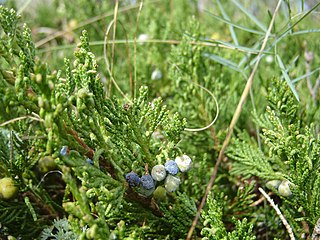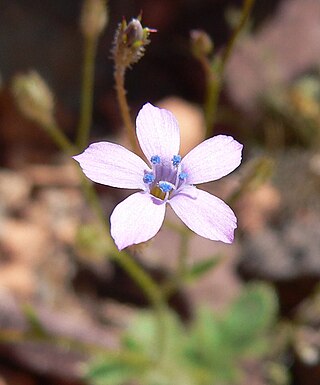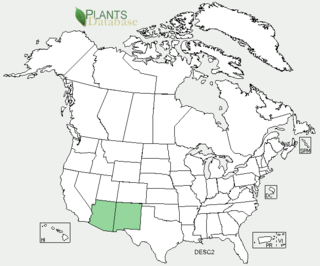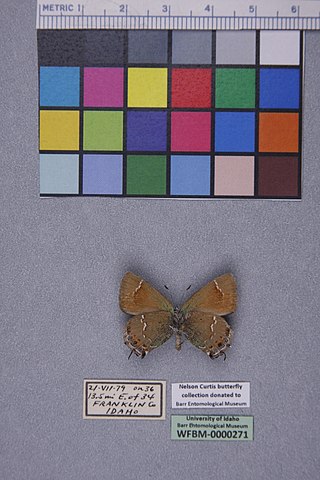
The Canadian Rockies or Canadian Rocky Mountains, comprising both the Alberta Rockies and the British Columbian Rockies, is the Canadian segment of the North American Rocky Mountains. It is the easternmost part of the Canadian Cordillera, which is the northern segment of the North American Cordillera, the expansive system of interconnected mountain ranges between the Interior Plains and the Pacific Coast that runs northwest–southeast from central Alaska to the Isthmus of Tehuantepec in Mexico.

Pinus ponderosa, commonly known as the ponderosa pine, bull pine, blackjack pine, western yellow-pine, or filipinus pine is a very large pine tree species of variable habitat native to mountainous regions of western North America. It is the most widely distributed pine species in North America.

Juniperus scopulorum, the Rocky Mountain juniper, is a species of juniper native to western North America, from southwest Canada to the Great Plains of the United States.

Juniperus horizontalis, the creeping juniper or creeping cedar, is a low-growing shrubby juniper native to northern North America, throughout most of Canada from Yukon east to Newfoundland, and in some of the northern United States.

The Virgin Mountains are a mountain range of the northeastern Mojave Desert, located in Clark County, southeastern Nevada and Mohave County, northwestern Arizona.

The Pancake Range is located in east-central Nevada in the United States. The range extends as an irregular sinuous line for approximately 90 miles (140 km) with a roughly north-south trend in Nye and White Pine counties. The range reaches an elevation of 9,240 feet (2,820 m) at Portuguese Mountain. Neighboring ranges include the White Pine, Grant and Quinn Canyon ranges across Railroad Valley on the east-southeast; and Park and Hot Creek ranges across Big Sandy Springs and Hot Creek valleys on the west-northwest. The south end of Newark Valley lies at the extreme north end of the range. The Lunar Crater Volcanic Field lies at the southwestern end of the chain with the Reveille Range to the south.

Conioselinum is a genus of flowering plant in the family Apiaceae, native to Eurasia and North America. Its species are erect perennial plants with deeply toothed compound leaves and umbels of white flowers. Plants of this genus are known commonly as hemlock-parsley.

Gilia scopulorum is a species of flowering plant in the phlox family known by the common names rock gilia and Rocky Mountain gilia. It is native to the Mojave and Sonoran Deserts.

Sgùrr Thuilm is a mountain in the Glenfinnan area of the Highlands of Scotland. It stands at the head of Glen Finnan approximately 7 kilometres (4 mi) north of Loch Shiel.

Phoradendron juniperinum is a species of flowering plant in the sandalwood family known by the common name juniper mistletoe. It is native to the southwestern United States and northern Mexico, where it grows in various types of woodland habitat. It has been reported from California, Nevada, Arizona, New Mexico, Oregon, Utah, Texas, Chihuahua and Sonora.

Juniperus maritima is a species of juniper known by the common name seaside juniper. It is native to the central Salish Sea region in southwestern British Columbia and northwestern Washington, where it is an endemic species and is abundant on coast bluffs as well as on dry mountain ridges on the Olympic Peninsula. It was previously included in the description of the Rocky Mountain juniper but was separated in 2007. Genetic analysis revealed that what appeared to be Rocky Mountain junipers in the Puget Sound were not of the same species as those elsewhere. The Puget Sound species also differs in morphology, with faster-maturing cones that have protruding seeds, and other differences. It is especially unique in habitat. The seaside juniper occurs at the edge of the water, next to the sound or the nearby lakes, in a milder, wetter climate on sandy, granite soils, even sand dunes in one location. J. scopulorum grows in drier, rockier substrates in colder locations higher in the mountains. It is also noted that seaside juniper reproduces itself and does not interbreed with other junipers, further evidence that it should be called a separate species.

Delphinium scopulorum, commonly known as Rocky Mountain larkspur, is a species of wildflower in the genus Delphinium, which belongs to the buttercup family, Ranunculaceae. It is native to the Southwestern United States and found predominantly in upper-elevation moist meadows.

Taylor Peak, elevation 13,158 ft (4,011 m), is a summit in the Front Range of north central Colorado. The peak is in Rocky Mountain National Park at the head of Loch Vale and just north of Taylor Glacier.

Resplendent Mountain, or Mount Resplendent is a peak in the Canadian Rockies, located within Mount Robson Provincial Park in British Columbia, Canada. It is a part of the Rainbow Range, and is a sister peak to the more famous Mount Robson, its nearest neighbour. Together they form a classic panorama seen by travellers from the VIA railway and Highway 16. The mountain was named by Arthur P. Coleman, and A.O. Wheeler wrote, "On the east side it is clad from top to bottom in pure white snow, and presents with the sun shining upon it a spectacle of such wonderful brilliance that the aptness of the name became immediately apparent." The first ascent was achieved on the same historic 1911 trip in which Conrad Kain first scouted the climbing routes later to be used on the first ascent of Mount Robson.

Cochemiea boolii is a species of cactus in the subfamily Cactoideae with pink-petaled flowers. It also has a natural defense system of thorns protecting the green base of the plant. Cochemiea boolii is native to the area around Phoenix, Arizona, found near mostly rocky soils, coastal mountains, and in thin forests and often seen with Echinocereus scopulorum, Echinocereus engelmannii, Mammillaria swinglei, and Ferocactus emoryi. Mammillaria boolii is considered "near threatened" by IUCN and is under threat by urban development.

Mitoura rosneri, the Rosner's hairstreak, is a butterfly of the family Lycaenidae. It is found in western North America in British Columbia. and Washington state. Subspecies C. r. plicataria is known as Barry's hairstreak.
Chrysothamnus scopulorum, called Grand Canyon glowweed or evening-daisy , is a North American species of flowering plants in the tribe Astereae within the family Asteraceae. It has been found only in northern Arizona and southern Utah.
Both naturally and artificially occurring pine species (Pinus) can hybridize, combining their genetic material and sometimes creating hybrids that can be more or less vigorous than their parent species. An example of a naturally occurring hybrid pine is Pinus × sondereggeri, a naturally occurring cross between loblolly pine and longleaf pine. An example of the many artificial hybrids is Pinus lambertiana × P. armandii.

Cirsium funkiae, the funky thistle or Funk's thistle, is a species of thistle found in the United States. It was first described by American botanist Jennifer Ackerfield in 2022.



















